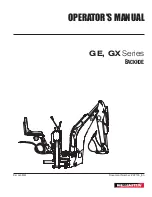
Introduction and Safety in the Workshop
1A-6
MF 533/543/563 - Issue 1
Compressed Air
·
The pressure from a compressed air line is often as
high as 7 bar (100lbf/in²). It is perfectly safe if used
correctly. Any misuse may cause injury.
·
Never use compressed air to blow dust, filings, dirt
etc., away from your work area unless the correct
type of nozzle is fitted and eye protection is used.
·
Compressed air is not a cleaning agent, it will only
move dust, etc., from one place to another. Look
around before using an air hose as bystanders may
get grit into their eyes, ears or skin.
·
Used approved air guns, wear safety goggles, and
use proper shielding to protect others in the work
area.
·
Never point an air nozzle at a persons body.
Hand Tools
·
Many cuts, abrasions and injuries are caused by
defective tools. Never use the wrong tool for the job,
as this generally leads either to some injury, or to a
poor job.
·
Never use:
-A hammer with a loose head or split handle.
-Spanners or wrenches with splayed or worn jaws.
-Spanners or files as hammers; or drills, clevis pins
or bolts as punches.
·
Grind off mushroom heads from chisels. The sharp
edges can tear your skin if the tool slips. And, when
the tool is struck, chips could break off and fly into
your eyes.
·
Keep a handle on every file to prevent the tang from
piercing your palm or wrist if the file should slip or
catch.
·
For removing or replacing hardened pins use a
copper or brass drift rather than a hammer.
·
For dismantling, overhauling and assembly of major
components, always use Special Service Tools
recommended.
These will reduce the work effort, labour time and
repair cost.
·
Always keep tools clean and in good working order.
Electricity
·
Electricity has become so familiar in day to day
usage, that its potentially dangerous properties are
often overlooked. Misuse of electrical equipment
can endanger life.
·
Before using any electrical equipment - particularly
portable appliances - make a visual check to make
sure that the cable is not worn or frayed and that the
plugs, sockets, etc., are intact; make sure you know
where the nearest isolating switch is located. Always
use an earthed (grounded) 3 pin electrical cord.
GENERAL CONSIDERATIONS
Solvents
·
Use only cleaning fluids and solvents that are known
to be safe. Certain types of fluids can cause damage
to components such as seals, etc., and can cause
skin irritation. Solvent labels should be checked that
they are suitable not only for the cleaning of
components and individual parts, but also that they
DO NOT affect the personal safety of the user.
Housekeeping
·
Many injuries result from tripping or slipping over or
on, objects or material left lying around by a careless
worker. Prevent these accidents from occurring. If
you notice a hazard, don’t ignore it - remove it.
·
A clean, hazard-free place of work improves the
surroundings and daily environment for everybody.
·
Keep work organised and clean. Wipe up spills of any
kind to minimize the possibility of a fall. Keep tools
and parts off the floor to further reduce the possibility
of tripping and causing serious injury.
Fire
·
Fire has no respect for persons or property. The
destruction that fire can cause is not always fully
realised. Everyone must be constantly on guard.
-Extinguish matches, cigars, cigarettes, etc., before
throwing them away.
-Work cleanly, disposing of waste material into
proper containers.
-Locate the fire extinguishers and find out how to
operate them.
-DO NOT permit or use open flame near the fuel tank,
fuel lines, battery, hydraulic hoses or component
parts
·
When using a gas torch, always keep a fully charged
fire extinguisher within reach.
·
In the event of fire:
-DO NOT panic - warn those near and raise the
alarm.
First Aid
·
In the type of work that mechanics are engaged in,
dirt, grease, fine dust, etc. all settle upon the skin and
clothing. If a cut, abrasion or burn is disregarded it
may be found that an infection has formed within a
short time. What appears at first to be trivial could
become painful and injurious. It only takes a few
minutes to have a fresh cut dressed, but it will take
longer if you neglect it. Make sure you know where
the First Aid box is located and that it is kept fully
stocked at all times.
Find manuals at https://best-manuals.com








































